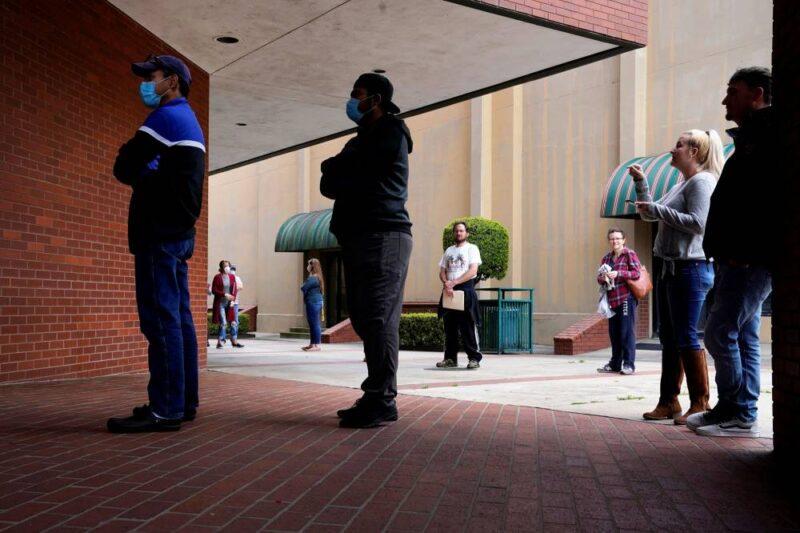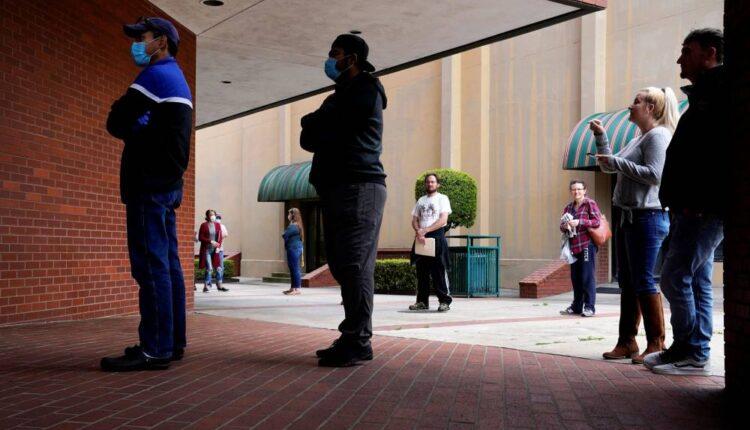
- Claims for unemployment benefits last week are expected to total about 5.25 million, bringing the number of Americans filing to more than 15 million.
- The claims initially were expected to have come from millions who lost their jobs in restaurants and travel-related fields, but now they are likely to include hundreds of thousands of retail workers.
- Economists say there could be more longer-term and permanent layoffs included in more recent claims, as companies look to trim costs.
People who lost their jobs wait in line to file for unemployment following an outbreak of the coronavirus disease (COVID-19), at an Arkansas Workforce Center in Fort Smith, Arkansas, April 6, 2020.Nick Oxford | Reuters
Another 5.25 million workers are expected to have filed unemployment claims last week, reflecting a larger swath of the country now under shutdown orders.
Together with the claims filed in the past two weeks, the total could now surpass 15 million. But that number is still probably millions shy of the number of workers who may have already lost their jobs as the economy abruptly shut down.
The unemployment claims report for the week ended April 4, is expected at 8:30 a.m. ET Thursday. It would be the third in a row to show millions of Americans filing claims. In the last two reports, a total 10 million workers had filed for state unemployment benefits.
Economists forecast that the unemployment rate will jump into the teens this month, from March's 4.4% level and the 3.5% it was at in February. They also estimate anywhere from 10 million to 20 million will show up in the monthly employment report as lost jobs.
"In the first wave you saw the first hit was to service workers. … Leisure was really large but retail is going to be big in the next wave … all the hundreds of thousands of retailers put workers on furlough," said Diane Swonk, chief economist at Grant Thornton. She said more manufacturing workers will also show up, as auto plants shut down production and related industries will also scale back.
In the first monthly employment report since the shutdowns, there was a decline of 701,000 nonfarm payrolls in March, and 479,000 were in the leisure industry, which includes restaurants, hotels and other travel services or entertainment related businesses. Restaurants were among the first businesses to close or downsize after President Donald Trump told Americans to stay out of restaurants and bars in mid-March.
Soon after came the retail closings, as states issued stay-at-home orders. Those closings have been sending ripples across the country. Mall owner Simon Properties, for instance, said on March 31 that it was furloughing 30% of its workers as some shuttered retailers and restaurants were expected to hold off on April rent.
In the retail sector itself, Macy's, which employed 130,000, said it was moving to an absolute minimum of workers needed to keep its basic operations going.
Gap also said it was furloughing the majority of its workers in the U.S.and Canada, or roughly 80,000. Nordstrom, L Brands, Urban Outfitters and Ascena were among the many retailers to announce they were furloughing workers. In addition, there are thousands of small, independent shops across America that shut down.
Economists have been looking at state filing numbers and also anecdotal news of layoffs since the claims reports are unable to reflect the real number of people who would be seeking benefits. The weekly claims data dwarf the highest previous levels of just under 700,000 claims in one week during the financial crisis and another in 1982.
Furloughed workers, who are off the job but are still receiving health care and other benefits, now qualify for unemployment, as do part-time workers.
The $1.2 trillion aid package approved by Congress last month broadened the group of people who can apply for claims to include part time workers and those who are furloughed.
As the shutdowns now cover states responsible for more than 90% of the country, employers are being forced to make tougher decisions about cost cutting and economists expect that means layoffs in all types of jobs across various industries.
"You're going to see more and more broad-based layoffs — temporary as well as long-term layoffs," she said. "The further we get into April, the more we're going to get beyond hourly workers to salaried workers." Those layoffs could be more permanent job losses.
There were 6.6 million claims reported last Thursday for the week ended March 28.
"We're going to come somewhere close to the number of claims we were at last week. Many of the states were overwhelmed, and they're still trying to process the backlog," Swonk said. "What we've laid bare is no system was meant to process the kinds of claims we're dealing with. No one expected this kind of volume, and the systems are antiquated."
Mark Cabana, head of U.S. short-rate strategy at Bank of America, said he expects the market to shrug off the number, no matter how large.
Generally, strategists say the market is trading off of the idea that some coronavirus data is signaling a peak number of cases is near, and it is looking for information on when the economy could reopen as its next catalyst.
"The markets have been clinging to optimism, " Cabana said. "The rates market barely budged for the employment report. It's baked in."
— CNBC's Lauren Thomas contributed to this story
Source: cnbc.com

